
Saturn, the sixth planet in our solar system, is known for its unique internal structure. It is the second largest planet, after Jupiter, in terms of size among all the planets orbiting the Sun. Scientists categorize Saturn as a gas giant, a type of planet composed mainly of hydrogen and helium. The planet was named after the ancient god of fertility, who was symbolized by a sickle.
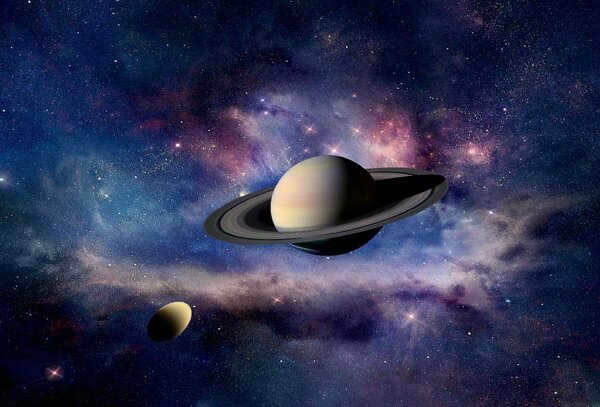
Saturn is known for its famous system of visible rings, which are composed of frozen gas particles, dust, and heavy elements. Currently, there are 63 satellites orbiting the giant planet. Among them, Titan is the largest and is considered the second largest satellite in the solar system after Ganymede, which belongs to Jupiter.
A significant event in the exploration of Saturn occurred in 1997 with the launch of the Cassini spacecraft into Saturn’s orbit. Arriving in 2004, the spacecraft has been studying the giant planet ever since. Its main objectives include investigating the rings, studying their structure, and observing dynamic processes in Saturn’s atmosphere and magnetic field.
Saturn: A Celestial Body in the Solar System
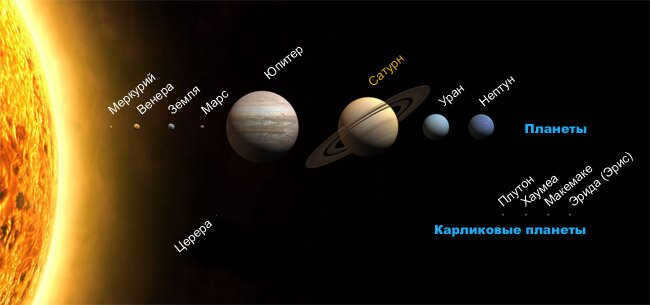
As previously mentioned, Saturn is categorized as a gas giant due to its lack of a solid surface and its composition primarily consisting of volatile substances, specifically gases. Saturn has an equatorial radius of 60.3 thousand kilometers and a polar radius of 54.4 thousand kilometers. It is worth noting that Saturn possesses the highest level of compression among all the planets within the solar system. The mass of this colossal planet is nearly 100 times greater than that of Earth. However, Saturn’s average density is approximately 0.7 g/cm2, making it the sole planet within our stellar system with a density lower than that of water. While there is a significant difference in mass between Saturn and Jupiter (nearly threefold), their equatorial diameters differ by only 19%. In terms of density indices, other gas giant planets exhibit much higher values.
Orbital characteristics and rotation
The distance from the Sun to Saturn is approximately 1,430 million kilometers. Saturn completes a full orbit around the massive Sun every 30 Earth years, which is equivalent to about 10,957.5 Earth days. This journey is made at a remarkable speed of 9.8 kilometers per second.
Interestingly, the various features present in Saturn’s atmosphere rotate at different speeds, which depends on their latitude. For instance, the complete rotation of Saturn on its axis takes approximately 10 hours and 34 minutes. What’s fascinating is that Saturn is the only planet in our solar system where the equatorial rotation rate is faster than its orbital rate.
According to researcher Williams, Saturn’s rotation speed is not constant and differs depending on the latitude, longitude, and time intervals. The study analyzed data from the equatorial region of the giant planet over a span of 200 years and found that the variability of its rotation period is primarily influenced by cycles, including semi-annual and annual ones.
Genesis of Saturn
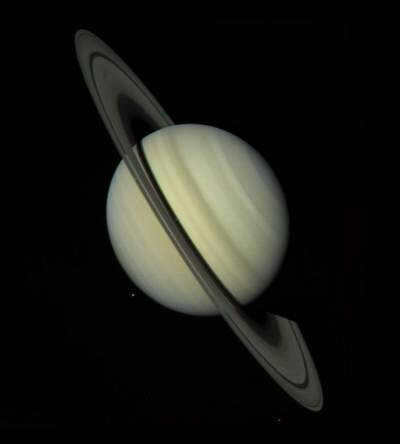
The origin of Saturn can be explained by two main hypotheses. The “contraction” hypothesis compares the gas giant to the Sun in terms of the number of orbiting bodies and the presence of a significant amount of hydrogen in their chemical composition. This can be explained by the fact that during the formation of planets in the early solar system, there were also large “condensations” of material. These condensations then began to form planets. Therefore, according to the first theory, Saturn was formed in a similar way to the Sun itself. However, this hypothesis fails to explain the difference in chemical composition between the Sun and Saturn.
As per the theory of “accretion”, Saturn’s formation occurred in two distinct stages. Advocates of this hypothesis propose that initially, the giant planet formed using the same principles as the solid planets. However, a significant change in the chemical composition of Saturn took place when streams of gas from the region of Jupiter began to consistently fall onto the planet. This marked the beginning of the second phase of Saturn’s formation. During this later period, a process of gas accretion occurred near the surface of the giant planet. The temperature of the outer layers of Saturn during this time soared to 2000 °C.
The composition and structure of Saturn’s atmosphere
The upper regions of the colossal planet’s atmosphere consist of a mere 3.5% helium, while the remaining 96.5% is composed of hydrogen. Additionally, there are trace amounts of phosphine, ammonia, ethane, and methane. During the Voyager missions, it was uncovered that Saturn boasts the most powerful wind currents. By employing orbiters, scientists were able to estimate their approximate velocity, which reaches up to 500 m/s. Typically, these winds blow in an easterly direction, gradually weakening as they move away from the equator. Their potential is significantly diminished when confronted by opposing westerly winds. Furthermore, researchers have discovered that this “movement” occurs both in the upper layers of Saturn’s atmosphere, where the clouds reside, and in the lower layers. Activity can be observed up to a depth of 2,000 kilometers. Utilizing measurements taken by the Voyager, scientists have determined that the winds consistently flow along the equator in both the northern and southern hemispheres.
Furthermore, within the planet’s atmosphere, there are intermittent occurrences of stable formations resembling extremely powerful hurricanes. Similar phenomena have previously been detected on other gas planets within our solar system. In the case of Saturn, the “Great White Oval” formations were first documented approximately 15 years ago. These formations also manifest on the planet at regular intervals, approximately once every 30 years.
In 2008, the Cassini spacecraft captured images of Saturn’s northern polar region using infrared photography. These images revealed the presence of polar auroras, which were considered to be a unique phenomenon within the solar system. Subsequent observations in the visible and ultraviolet bands provided new insights into these auroras. Typically, the auroras in Saturn’s polar region take on a ring-shaped form, although occasionally they may appear spiral or oval. The polar lights exhibit a blue color, while the clouds below them appear red.
Unlike Jupiter’s auroras, the origin of Saturn’s auroras is not attributed to the irregular rotation of plasma layers within the magnetosphere. Many scientists believe that these auroras are instead caused by the impact of solar winds. Furthermore, the appearance and shape of Saturn’s auroras can vary over time.
Powerful lightning discharges can be observed on Saturn during specific periods characterized by strong magnetic storms and storms. These discharges have a significant impact on the planet’s electromagnetic activity, which is known to be inherently unstable. In 2010, the Cassini spacecraft successfully captured a storm on Saturn that appeared reminiscent of smoke from a cigarette. Another equally intense storm was also documented by the spacecraft in the middle of 2011.
The Hexagonal Formation at Saturn’s North Pole
An extraordinary phenomenon can be observed near the north pole of Saturn – a hexagonal figure known as the Saturn’s hexagon. This peculiar formation was first documented in the 1980s through images captured by the Voyager spacecraft. It has since been recognized as a unique feature within our solar system. The enigmatic hexagonal shape is situated at a latitude of 78 degrees and rotates with a period of 10 hours and 40 minutes, which coincides with the variation in radio emission from the planet.
Further investigation revealed that the clouds composing the hexagon possess uncommon structures. Remarkably, research conducted in 2006 demonstrated that this formation has remained stable for over two decades.
A detailed explanation for the discovered phenomenon has yet to be found by anyone. However, scientists have successfully simulated the structure of Saturn’s atmosphere and identified the likely causes for the formation of these distinctive clusters. In their experiment, they took a 30-liter cylinder of water and affixed it to a rotating surface. Inside the cylinder, they placed rings of varying diameters, which spun at a faster rate than the container itself. They observed that as the rotation speed of the rings increased, the shape of the vortex deviated further from a perfect circle. Ultimately, the scientists were able to recreate a hexagonal vortex through this experiment.
The internal structure of Saturn
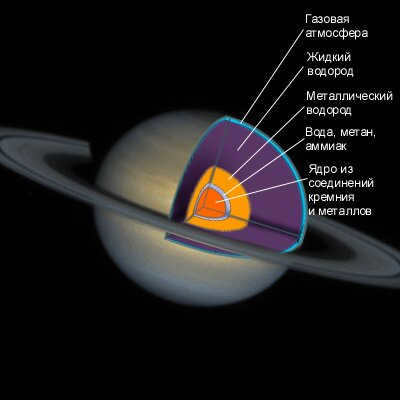
The structure of Saturn’s magnetic field
The configuration of Saturn’s magnetic field was first observed during the Pioneer 11 orbiter mission in 1979. It was discovered that Saturn’s magnetosphere is the second largest in the solar system, surpassed only by Jupiter’s magnetosphere. The region between Saturn’s magnetosphere and the area influenced by the solar wind extends to a distance approximately equal to 20 times the radius of Saturn. The tail of the magnetosphere extends several hundred times this distance. Saturn’s magnetosphere is composed of plasma generated by the planet itself and its moons. One moon in particular, Enceladus, and its geysers play a significant role in this process. The geysers emit water vapor, which becomes ionized by Saturn’s magnetic field.
Exploring Saturn
Saturn, one of the largest planets in our solar system, is easily visible from Earth without the need for special optics. With a luminosity that exceeds first magnitude, Saturn is a breathtaking sight. However, to truly appreciate its beauty, a telescope with a diameter of 15 mm or larger is required to observe its iconic rings. With the help of a high-magnification instrument, it is possible to see the darker “cap” at the planet’s poles and even the shadow cast by Saturn’s rings. And for those equipped with a telescope boasting an aperture of 150-200 mm, the five distinct bands of atmospheric clouds can be observed, adding to the wonder of studying this magnificent planet.
In the early 17th century, Galileo Galilei made the first observation of Saturn using a telescope. Instead of appearing as a single, uniform celestial object, Saturn appeared as three distinct objects positioned next to each other. Initially, it was believed that two of these objects were large satellites of the planet. However, a few years later, Galileo himself found no evidence of these supposed satellites. In the mid-17th century, Huygens used a more powerful instrument and discovered that these “satellites” were actually a thin ring encircling the planet, not directly touching it. Additionally, scientists identified Titan, the largest satellite of Saturn. In the late 17th century, Giovanni Cassini embarked on an extensive study of the giant planet. During his research, he determined that the large ring is actually composed of two separate rings with a gap between them, which became known as the “Cassini gap”. Furthermore, scientists also discovered several other satellites of Saturn, including Rhea, Japetus, Tethys, and Dione.
It was only towards the end of the 18th century that W. Herschel made the groundbreaking discovery of two previously unknown satellites of Saturn, namely Mimas and Enceladus. Following this, British astronomers stumbled upon the peculiarly-shaped satellite Hyperion. Then, at the close of the 20th century, William Pickering made the remarkable discovery of Theba, an irregular satellite of Saturn. Meanwhile, in the 1940s, Gerard Kuiper astounded the scientific community by revealing the presence of a robust atmosphere on Titan, the largest satellite of the gas giant. This phenomenon was completely unprecedented among the satellites of the planets within our solar system.
Fast forward to the 1990s, when Saturn, along with its impressive collection of satellites and intricate ring system, underwent extensive scrutiny through the lenses of the Hubble telescope. These close observations led to the revelation of numerous new findings that had remained undiscovered during the brief flybys conducted by Pioneer 11 and the Voyager spacecraft over the planet.
The exploration of Saturn was carried out by the Cassini-Huygens, Pioneer 11, Pioneer 22, and Voyager spacecraft
In 1979, the first-ever encounter with Saturn was made by the American automated spacecraft Pioneer-11. The mission, which began in August, aimed to conduct a thorough exploration of the planet. In early September of that year, Pioneer-11 made its closest approach to Saturn, capturing unique photographs of various regions on the planet and its moons. Unfortunately, the resolution of the imaging devices on board was not high enough to provide clear pictures of Saturn’s surface. Additionally, the lack of sunlight contributed to the darkness of the images. To gather more information about Saturn’s enigmatic rings, the spacecraft was maneuvered to fly beneath them, leading to the discovery of the delicate F ring. Furthermore, Pioneer-11’s mission involved measuring the temperature of Titan, one of Saturn’s moons.
The year 1997 marked the beginning of the research conducted by the Cassini-Huygens station, which successfully reached Saturn’s system and entered the planet’s orbit. The primary objective of this mission was to extensively study the composition and structure of Saturn’s rings, along with all of its known satellites. Additionally, scientists aimed to investigate the magnetosphere and atmosphere dynamics of the gas giant, while also conducting a comprehensive analysis of its largest moon, Titan.
In 2004, prior to entering orbit around the planet, the station passed through the orbital area of Phebe, capturing images and transmitting them back to Earth. Additionally, the American spacecraft Cassini has made multiple close encounters with Titan, allowing for the observation and documentation of its lakes, islands, and mountains. Shortly thereafter, the European probe Huygens separated from the American craft to descend towards the planet’s surface. The parachute-assisted descent lasted approximately 2.5 hours, during which the probe collected samples of the gas giant’s atmosphere. Subsequent analysis revealed that the lower cloud layers consist of liquid nitrogen and methane, while the upper layers are composed of methane-derived ice.
In 2005, scientists first detected radiation emanating from Saturn. In January 2006, a violent storm was observed on the gas giant, resulting in a flash of radiation that was 1000 times stronger than normal. Around the same time, NASA announced the potential presence of water in the liquid expelled by the geysers of Enceladus. Then, in 2011, NASA officials declared Enceladus to be the most promising celestial body in our solar system for supporting life. The images captured by the Cassini spacecraft also led to other significant discoveries. Upon analyzing the spacecraft’s images, scientists were able to identify two new rings around Saturn – R/2004 S1 and R/2004 S2. These rings were believed to have formed from the collision of a comet or meteorite with either Epimetheus or Janus. In 2006, Cassini conducted a survey that led to the discovery of a hydrocarbon lake near the north pole of Titan, Saturn’s largest moon. This finding was later confirmed in 2007.
In 2008, the spacecraft “Cassini” transmitted images to Earth that showed the northern hemisphere of Saturn. It was discovered that significant changes had occurred on the planet since 2004, when the spacecraft was last in its vicinity. Over the course of four years, Saturn had developed entirely new colorations, leaving scientists puzzled as to the cause of this phenomenon. The only hypothesis they could offer was that it might be linked to seasonal variations.
During the “Cassini” mission, which took place from 2004 to 2009, a total of 8 new satellites of the giant planet were discovered. The main objectives of the mission were successfully accomplished by the spacecraft in 2008. However, “Cassini” remained in the vicinity of Saturn until 2010. Scientists have stated that, as of now and until 2017, the probe’s task is to study the seasonal cycles of the gas planet.
In 2009, a decision was made to initiate a new joint project between NASA and ESA, which involved launching another interplanetary spacecraft to the Saturn region, specifically targeting its two moons – Enceladus and Titan. The goal of this space mission was for the spacecraft to eventually become a satellite of Titan itself after 8 years of travel.
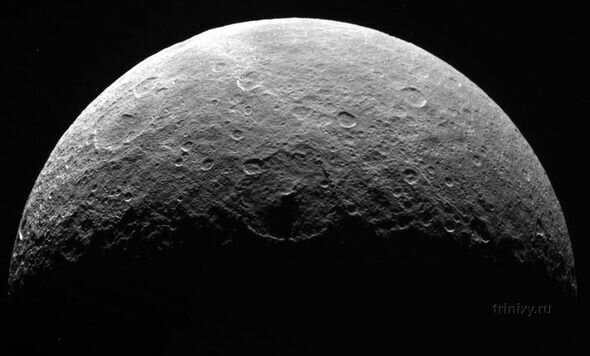
The most notable moons of Saturn include Titan, Enceladus, Tepheus, Mimas, Rhea, Dione, and Japetus. These celestial bodies were first observed in the 18th century, and their exploration and research have persisted to this day. Their sizes vary, with diameters spanning from 400 to 5200 kilometers. Among them, Titan possesses the highest orbital eccentricity, while Tefia and Dione demonstrate the lowest.
Titan, the biggest moon of Saturn, stands out for its unique chemical composition and atmospheric structure. While it shares similar proportions of rock and water ice with other gas planets, Titan’s atmosphere is primarily composed of nitrogen with traces of methane and ethane, which contribute to the formation of clouds. Notably, water has been discovered on Titan’s surface, making it the only celestial body, aside from our own planet, where this vital element has been found. Because of this, scientists speculate about the possibility of life in the form of protozoan organisms existing on Titan.
There are also unique characteristics among Saturn’s other moons. For instance, Japet displays varying albedos on each hemisphere. This led to its discovery by Giovanni Cassini, who observed that it is only visible from a specific side of Saturn. Rhea and Dione also possess their own distinct features. One hemisphere of Dione is heavily cratered, while its posterior hemisphere is marked by darkened regions punctuated by bright icy ridges and cliffs. Mimas is notable for its Herschel crater, measuring 130 kilometers in diameter. Tethys also boasts a massive crater, spanning 400 kilometers in diameter. As for Enceladus, another sizable moon of Saturn, Voyager-2 images suggest that its surface exhibits varying geological ages.
Research carried out in Hawaii since 2006, using the assistance of the Subaru telescope from Japan, has led to the identification of an additional 9 satellites of the gas giant. These newly discovered satellites all have irregular orbits, moving in a retrograde direction.
As of 2010, scientists have knowledge of 62 satellites orbiting Saturn. The rotation of all the known satellites, except for Phebe and Hyperion, is considered to be synchronous and proper. This means that only one side of these satellites is always facing towards Saturn. Unfortunately, there is currently no available data regarding the rotation of the smaller satellites.
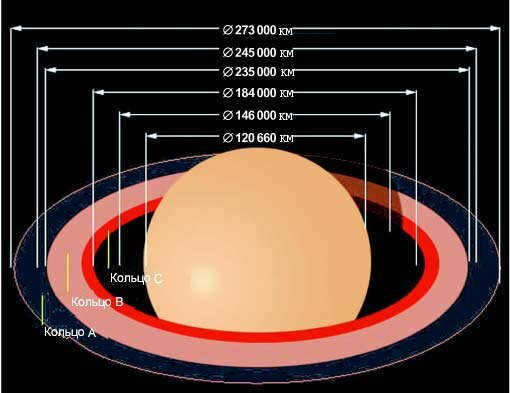
Up until now, it has been determined that all of the gas planets in our solar system possess rings. However, Saturn boasts the most extensive rings out of all of them. These rings are positioned at an angle of nearly 28° in relation to the ecliptic plane, which is why they always appear different when viewed from Earth’s surface. Huyss proposed the idea that these rings are not solid bodies, but rather consist of the tiniest fragments situated within the vicinity of the planet’s orbit. This hypothesis has been fully substantiated by spectrometric observations conducted by A.A. Belopolsky.
Saturn possesses a trio of primary rings and an additional, more slender ring. These rings have a higher reflectivity than the planet’s disk. The scientific community has deemed the three primary rings with uppercase Latin letters. The “B” ring stands as the central, most luminous, and largest one. It is separated from the “A” ring by the Cassini division, which also encompasses thin rings. Within the “A” ring, there is also a narrow division known as the Enke separation band. The “C” ring is noted for its nearly transparent nature.
The rings of the massive celestial body are incredibly slender. They measure about 250 thousand kilometers in diameter but have a thickness of less than a kilometer. Their visibility is due to the concentration of matter within them. If this matter were to be condensed, the resulting monolith would have a diameter no greater than 100 kilometers. Observations of Saturn support the theory that these rings are made up of even thinner rings that are separated by gaps. 93% of the rings’ composition is ice with impurities. Surprisingly, the particles that form the rings are quite small, ranging from 1 cm to 10 meters in size.
There is also a certain regularity in the movement of the particles of Saturn’s rings and satellites. Some of it pertains to the so-called “shepherd satellites” that keep the rings around the planet in place. Mimas is in resonance with Cassini’s division in a 2-to-1 ratio. The force of gravity acts on the matter of Mimas and causes it to drift away. In 2010, when data from the Cassini spacecraft was collected, researchers discovered that Saturn’s rings experience certain fluctuations. The prevailing belief is that these are caused by interactions between particles within the rings. The true origin of Saturn’s rings has not been fully revealed. According to one hypothesis proposed by E. Roche in the mid-19th century, they formed as a result of the breakup of a liquid satellite under the influence of tidal forces. Another popular theory suggests that the satellite disintegrated due to the impact of a comet or another celestial body.
According to one hypothesis, scientists also speculate the presence of rings in one of Saturn’s satellites – Rhea.
In 1921, a widespread rumor circulated about the planet Saturn. It was said that Saturn had lost its iconic rings, with the particles scattering throughout the Galaxy and on a collision course with Earth. This news captivated the minds of people everywhere, and newspapers even published detailed calculations predicting when the ring fragments would make impact. The reason behind these rumors was that the rings had turned their edges towards Earth and its observers, rendering them invisible to the instruments of that time. The literal “disappearance” of the rings fueled the spread of this rumor.
Additionally, it is worth noting that Saturn’s name is deeply rooted in mythology.
The celestial body was given its name in honor of the ancient Roman deity associated with agriculture. In a later period, it became associated with the titan Cronus. Because of the mythological tale that the deity devoured his own offspring, the ancient Greeks did not hold Saturn in high regard. However, the Romans revered this god. It was believed that Saturn bestowed upon humans the knowledge of cultivating crops and constructing dwellings. The era of his legendary rule was considered the “golden age of humanity”. In his honor, people organized festivities called Saturnalia, during which all individuals temporarily gained freedom.
The latest updates on the subject:
- 02.01.2018 20:24
 Recent findings from the Cassini spacecraft
Recent findings from the Cassini spacecraft- 22.11.2017 22:29
 Reconstruction of the Cassini’s descent into Saturn’s atmosphere
Reconstruction of the Cassini’s descent into Saturn’s atmosphere- 13.11.2017 21:57
 Occurrences of methane showers on the moon Titan
Occurrences of methane showers on the moon Titan- 14.09.2017 21:31
 A new initiative to explore Titan
A new initiative to explore Titan- 11.07.2017 22:27
 Japet is an extraordinary moon orbiting around Saturn
Japet is an extraordinary moon orbiting around Saturn- 26th June 2017 at 20:09
 Cassini’s ultimate mission
Cassini’s ultimate mission- 25th May 2017 at 22:00
 Saturn’s rings cast a shadow on the planet
Saturn’s rings cast a shadow on the planet- 17th May 2017 at 22:19
 Cassini discovers propellers within Saturn’s rings
Cassini discovers propellers within Saturn’s rings- 4th May 2017 at 18:06
 Dragonfly multicopter sent to explore Saturn’s moon
Dragonfly multicopter sent to explore Saturn’s moon- 2nd May 2017 at 20:39
 The expedition of the Cassini spacecraft comes to an end
The expedition of the Cassini spacecraft comes to an end
Saturn, known as the sixth farthest planet from the center of our solar system, holds the distinction of being the second largest planet after Jupiter. Experts categorize Saturn as a gas giant, and it received its name in tribute to the ancient deity associated with fertility, symbolized by the sickle.
The planet is primarily composed of hydrogen, with trace amounts of helium, methane, ammonia, and water molecules. The core of the planet is made up of iron, ice, and nickel, covered by a layer of metallic hydrogen and a light gas shell. From a space perspective, the planet’s atmosphere is relatively uniform and calm, although it does contain large formations. In certain areas, the wind speed can reach up to 1800 km/h, surpassing similar measurements on Jupiter. Saturn’s magnetic field strength falls somewhere between that of Earth and Jupiter. Specifically, the giant’s magnetic field extends nearly 1 million kilometers towards the Sun.
One of Saturn’s notable features is its renowned system of visible rings. These rings are composed of frozen gas particles, dust, and heavy elements. Currently, there are 63 satellites orbiting around Saturn due to its influence. Among them, Titan is the largest and is considered the second largest satellite in the solar system, after Ganymede, which belongs to Jupiter.
In 1997, the Cassini interplanetary spacecraft was launched into Saturn’s orbit. It successfully reached the Saturn system in 2004 and has been conducting observations of the planet ever since. The primary objective of the spacecraft is to investigate the rings, their structure, as well as the dynamic processes occurring in Saturn’s atmosphere and magnetic field.
As previously mentioned, Saturn is classified as a gas giant due to its lack of a solid surface and its composition mainly consisting of volatile gases. Saturn has an equatorial radius of 60.3 thousand kilometers and a polar radius of 54.4 thousand kilometers. It is noteworthy that Saturn possesses the greatest compression among all the planets in the solar system. The mass of this giant planet is nearly 100 times that of Earth, yet its average density is approximately 0.7 g/cm2. This density measurement indicates that Saturn is the sole planet within our star system with a density lower than that of water. Despite having a mass difference of nearly 3 times compared to Jupiter, the equatorial diameter difference between the two is only 19%. In comparison to other gas giant planets, their density values are significantly higher.
Characteristics of Saturn’s Orbit and Rotation
Saturn is located at a distance of 1430 million kilometers from the Sun. It takes nearly 11 thousand days for Saturn to complete one full orbit around the giant star, with a rotation rate of 9.8 km/s. This is equivalent to approximately 30 Earth years.
The objects visible in Saturn’s atmosphere rotate at different speeds depending on their latitude.
Saturn completes a full rotation on its axis in 10 hours and 34 minutes. Interestingly, Saturn is the only planet where the rotation rate at its equator is faster than its orbital rate.
According to researcher Williams, the rotation speed of Saturn changes not only in different latitudes and longitudes, but also over different time periods. The variability of the equatorial region’s rotation period over 200 years suggests that it is primarily influenced by cycles, specifically semi-annual and annual cycles.
Origin of Saturn
There are two main hypotheses explaining the origin of Saturn. The first hypothesis, known as the “contraction” hypothesis, compares the gas giant to the Sun in terms of the number of celestial bodies orbiting around them and the significant presence of hydrogen in their chemical compositions. This hypothesis suggests that during the formation of planets in the early solar system, massive “condensations” also formed. It is from this material that planets began to take shape. In other words, according to this theory, planets, including Saturn, formed in a similar way to the Sun itself. However, this hypothesis fails to explain the difference in the chemical compositions of the Sun and Saturn.
The composition and formation of Saturn’s atmosphere
The upper layers of Saturn’s atmosphere contain 3.5% helium and the remaining 96.5% hydrogen, along with traces of phosphine, ammonia, ethane, and methane. The Voyagers missions revealed that Saturn experiences the strongest wind currents in the solar system. Utilizing orbiters, scientists estimated the wind speeds to be approximately 500 m/s. These winds predominantly blow in an eastward direction, gradually weakening as they move away from the equator. The western winds counteract the strength of the eastward winds, resulting in decreased velocity. The movement of these winds is not limited to the upper layers of Saturn’s atmosphere where the clouds reside, but also occurs in the lower layers. Even at depths of up to 2,000 kilometers, there is noticeable activity. Measurements taken by Voyager confirmed that the winds consistently flow along the equator in both the northern and southern hemispheres.
A group of British astrophysicists have made a groundbreaking discovery on Saturn – a new type of aurora that forms a ring around one of the gas giant’s poles.
In addition, the planet’s atmosphere occasionally produces stable formations in the shape of incredibly powerful hurricanes. Similar phenomena have been observed on other gas planets in our solar system. The “Great White Oval” was first detected by spacecrafts approximately 15 years ago, marking the first time it had been observed on Saturn. This unique formation appears on the planet every 30 years.
Back in 2008, the north pole of the planet was captured by the interplanetary automatic station “Cassini” through its lens. The images were taken using infrared technology during the study. Scientists were amazed to discover polar auroras, a rare and extraordinary phenomenon among all the planets in our solar system. Additionally, the team managed to obtain new and enhanced images of the auroras using visible and ultraviolet filters. Interestingly, the polar auroras found in Saturn’s pole area typically appear as ring-shaped, although they can occasionally take on a spiral or oval form. These mesmerizing auroras showcase a beautiful blue hue, which contrasts stunningly with the red clouds below.
Saturn experiences intense magnetic storms and thunderstorms during specific periods, resulting in the occurrence of impressive lightning discharges. These discharges have a significant impact on the planet’s ever-changing electromagnetic activity. Back in 2010, the Cassini spacecraft successfully documented a storm on Saturn that bore a resemblance to smoke from a cigarette. Another equally powerful storm was also documented by the station in the middle of 2011.
The Hexagonal Formation at Saturn’s North Pole
A hexagonal figure known as a hexagon has formed near Saturn’s north pole due to the accumulation of clouds. This unique phenomenon was first observed in the 1980s when analyzing images from the Voyager station. The giant hexagon, located at a latitude of 78°, has a rotation period of 10 hours and 40 minutes, which coincides with the period of radio emission changes on the planet.
Further research revealed that the clouds within the hexagon have unusual structures. Additionally, studies conducted in 2006 confirmed that this formation has remained stable for 20 years.
It is worth noting that while some clouds on Earth can also exhibit a hexagonal shape, the hexagons on Saturn have a more uniform and regular appearance.
So far, no one has been able to come up with a comprehensive explanation for the phenomenon that has been discovered. However, scientists have successfully simulated the structure of Saturn’s atmosphere and have identified potential factors that could contribute to the formation of these unique clusters. In their experiment, they took a 30-liter water cylinder and secured it to a rotating surface. Inside the cylinder, they placed rings of varying diameters that rotated at a faster pace than the container itself. They observed that as the speed of rotation increased, the shape of the vortex began to diverge from its original circular form. Ultimately, the scientists were able to create a hexagonal vortex through their experiment.
The internal structure of Saturn
The structure of Saturn’s magnetic field
The discovery of Saturn’s magnetic field occurred during the Pioneer 11 orbiter mission in 1979. It was revealed that the size of Saturn’s magnetosphere is second only to that of Jupiter. The region between Saturn’s magnetosphere and the area affected by the solar wind is located at a distance equal to 20 times the radius of the planet. The tail of the magnetosphere extends several hundred radii. Saturn’s magnetosphere consists of plasma generated by the planet itself and its moons. One important contributor to this plasma is Enceladus, particularly its geysers, which emit water vapor that becomes ionized by Saturn’s magnetic field.
The polar lights surrounding Saturn’s poles are a visual indication of the interaction between its magnetosphere and the solar wind. These auroras are characterized by their oval shape and vibrant colors. They form when energy is released as a result of the magnetosphere and solar wind interaction. Saturn’s atmosphere allows for the observation of these auroras across the infrared, visible, and ultraviolet spectrums. Similar to Jupiter, Saturn’s magnetic field is generated by the circulation of metallic hydrogen in its outer core layers.
Saturn possesses a dipole magnetic field, similar to that of Earth, with south and north poles. The gas giant’s magnetic dipole is directly linked to its axis rotation, resulting in an asymmetrical field. The dipole is slightly displaced towards the north pole along the planet’s axis.
The internal magnetic field of Saturn diverts the solar wind from its surface, preventing direct interaction with the atmosphere. It also influences the composition of the planet’s magnetospheric plasma, creating a distinction from the solar wind’s composition. Similar to Earth, the boundary separating the magnetosphere and the solar wind is known as the magnetopause. The distance from the magnetopause to the core of Saturn ranges from 16-27 Rs, with the exact distance influenced by the current solar wind pressure, which is dependent on the star’s activity. On average, the distance from the planet to the magnetopause is accepted to be 22 Rs. The magnetosphere’s extended tail is formed due to the impact of strong solar wind streams.
Saturn investigations
Saturn is one of the top five planets in our solar system that can be observed from the surface of the Earth without the need for specialized optics. The brightness of Saturn is higher than that of the brightest stars. To catch a glimpse of Saturn’s magnificent rings, a telescope with a diameter of at least 15 mm is required. By using high-magnification instruments, one can even spot the darker “cap” at the poles of the planet and the shadow cast by its rings. With an aperture size ranging from 150 mm to 200 mm, it is possible to observe the presence of five prominent bands of atmospheric clouds.
In the late 18th century, W. Herschel made a groundbreaking discovery when he identified two previously unknown moons orbiting Saturn: Mimas and Enceladus. Shortly after, British astronomers stumbled upon Hyperion, a peculiar satellite with an irregular shape. Then, at the end of the 20th century, William Pickering uncovered Theba, another irregular moon of Saturn. In the 1940s, Gerard Kuiper made a significant announcement about Titan, the largest moon of the gas giant, revealing the presence of a robust atmosphere, a phenomenon unprecedented among the moons of the planets in our solar system.
During the 1990s, the Hubble telescope carried out extensive studies of Saturn, its rings, and its moons. These close observations yielded a wealth of new information that had remained elusive during the brief flybys conducted by Pioneer 11 and Voyager spacecraft.
The exploration of Saturn was conducted by the spacecrafts Cassini-Huygens, Pioneer 11, Pioneer 22, and Voyager.
In 1979, the Pioneer-11, an unmanned spacecraft from the United States, made history by flying close to Saturn, becoming the first time this has been achieved in the field of astronomy. The mission to explore the planet began in August of that year, with the spacecraft reaching its closest approach to Saturn’s surface in early September. During this time, the spacecraft captured unique images of various regions of the planet and its moons. However, the resolution of the instruments used for observation was not sufficient to obtain clear images of Saturn’s surface, and the lack of sunlight resulted in dark images. In order to gather more information about Saturn’s enigmatic rings, the spacecraft was directed towards them and passed beneath the rings, leading to the discovery of the thin F ring. In addition to studying the planet, the Pioneer-11 mission also involved measuring the temperature of Saturn’s moon, Titan.
Following the research conducted by Pioneer-11, the exploration of Saturn continued with the involvement of the American spacecraft Voyager-1 and Voyager-2. Voyager-1 approached Saturn on November 13, 1980, capturing significantly higher quality images compared to those taken by Pioneer-22. Additionally, the mission successfully obtained high-resolution images of Saturn’s moons, including Titan, Rhea, Enceladus, Dione, Mimas, and Tefia. Notably, Voyager-1 managed to approach Titan at a distance of 6.5 kilometers, providing valuable insights into the satellite’s atmosphere and surface temperature. The mission revealed that Titan possesses an extremely dense atmosphere, hindering the passage of sunlight and resulting in lower quality image capture.
In 1997, the Cassini-Huygens probe successfully arrived at the Saturn system and successfully entered the planet’s orbit, initiating a comprehensive investigation of the gas giant. The primary objective of this mission was to conduct a meticulous examination of the composition and structure of Saturn’s rings and all known satellites. Furthermore, scientists aimed to analyze the dynamics of the planet’s magnetosphere and atmosphere, while also maximizing the exploration of Saturn’s largest satellite, Titan.
In 2004, before the station started orbiting the planet, it passed through the orbital area of Phebe, safely capturing images and transmitting them back to Earth. Additionally, the American spacecraft Cassini has made several close encounters with Titan. As a result, it was able to capture footage of the moon’s lakes, islands, and mountains. Shortly after, the European probe Huygens separated from the American spacecraft to approach the planet’s surface. The descent via parachute lasted approximately 2.5 hours. During this time, the probe collected samples of the gas giant’s atmosphere. Subsequent analysis revealed that the lower cloud layers consist of liquid nitrogen and methane, while the upper layers are composed of methane ice.
In 2005, researchers began observing radiation being emitted from Saturn. In January 2006, a violent storm was recorded on the gas giant, causing a flare that was 1000 times more intense than the planet’s usual radiation levels. Around the same time, NASA announced the potential presence of water in the liquid expelled by the geysers on Enceladus. In 2011, NASA officials declared that Enceladus is the most promising celestial object in the solar system for supporting life. Additionally, images captured by the Cassini spacecraft aided in making other significant discoveries. Upon analyzing the spacecraft’s images, scientists were able to identify two new rings around the planet – R/2004 S1 and R/2004 S2. It is believed that these rings formed as a result of a comet or meteorite colliding with either Epimetheus or Janus. In 2006, Cassini conducted a survey that led scientists to discover a hydrocarbon lake on the surface of Titan, located near its north pole. This finding was further confirmed by a subsequent survey in 2007.
In 2008, the Cassini spacecraft transmitted images of Saturn’s northern hemisphere back to Earth. These photographs revealed significant changes that had occurred on the planet since the spacecraft’s last visit in 2004. Over the four-year gap, Saturn had transformed, displaying new and different shades that scientists have yet to fully understand. One possible explanation for this phenomenon is the shift in seasons, but further research is needed to confirm this hypothesis.
Saturn and its moons
Titan, Enceladus, Tephea, Mimas, Rhea, Dione, and Japetus are the largest moons of Saturn. They were first observed in the 18th century and research on them is still ongoing. These objects have diameters ranging from 400 to 5200 kilometers. Among them, Titan has the highest orbital eccentricity, while Tefia and Dione have the lowest.
Titan, the largest moon of Saturn, stands out due to its unique chemical composition and atmospheric structure. Comprised mostly of rock and water ice, with an equal distribution of 50% each, Titan shares similar proportions with other gas planets. However, its atmosphere is distinct, primarily consisting of nitrogen with traces of methane and ethane, which contribute to cloud formation. Remarkably, Titan is the only known celestial body, aside from Earth, where water has been discovered on its surface. As a result, scientists speculate on the possibility of finding protozoan organisms and potential signs of life on this enigmatic moon.
Other moons of Saturn also possess their own unique characteristics. For instance, Japet exhibits varying albedos on each of its hemispheres. This discovery led Giovanni Cassini, the astronomer who first observed the moon, to note that it is only visible when positioned on a specific side of Saturn. Rhea and Dione also boast distinct hemispheric features. In one hemisphere of Dione, a multitude of craters can be found, while the opposite hemisphere is dotted with darkened regions interspersed with bright, gleaming lines that are, in truth, ice ridges and cliffs. The standout attribute of the moon Mimas is the Herschel crater, which spans 130 kilometers in diameter. Similarly, the moon Tefia is home to a colossal crater, measuring 400 kilometers in diameter. As for Enceladus, another sizable satellite of Saturn, the Voyager-2 images suggest that its surface areas exhibit varying geologic ages.
Research conducted in Hawaii since 2006 using the Japanese telescope Subaru has led to the discovery of an additional 9 satellites orbiting the gas giant. These newly found satellites are classified as irregular satellites due to their retrograde orbit.
Up until 2010, scientists had identified a total of 62 satellites orbiting Saturn. The rotation of all the known satellites, except for Phebe and Hyperion, is described as synchronous proper, meaning only one side of the satellites always faces Saturn. Currently, there is no available data on the rotation of the smaller satellites.
As of now, it has been determined that rings exist around all the gas planets in our solar system. However, Saturn possesses the most expansive rings. These rings are positioned at an inclination of nearly 28° in relation to the plane of the Earth’s orbit. This is why they appear different from the surface of our planet. Huyss proposed the theory that these rings are not solid masses, but are instead composed of tiny fragments situated within the vicinity of the planet’s orbit. This hypothesis has been fully substantiated by spectrometric observations conducted by A.A. Belopolsky.
Saturn features a primary trio of rings, distinguished by capital Latin letters, as well as a secondary, narrower ring. These rings have a higher light-reflecting capability compared to the planet’s own disk. The central ring, referred to as “B,” stands out as the brightest and largest, with the “A” ring being separated by the Cassini division and encompassing thinner rings. Inside the “A” ring, there is an additional narrow band known as the Enke separation. The “C” ring, on the other hand, is described as nearly transparent.
The rings of the giant planet are incredibly slender, with a diameter of around 250,000 kilometers. Surprisingly, each ring is less than 1 kilometer thick. Their visibility is due to the significant amount of matter they contain. If this matter were condensed, it would form a monolith with a diameter no larger than 100 kilometers. Detailed images captured during the study of Saturn provide evidence that these rings are actually composed of even thinner rings, separated by gaps. About 93% of their composition is icy material with impurities. The particles comprising the rings are remarkably small, ranging in size from 1 centimeter to 10 meters.
There is a certain regularity in the movement of the particles of Saturn’s rings and satellites. Some of this can be attributed to the “shepherd satellites” that keep the rings in place around the planet. Mimas is in resonance with Cassini’s gap at a 2-to-1 ratio. The gravitational force affects the matter of Mimas, causing it to move away. In 2010, scientists discovered that Saturn’s rings experience certain oscillations based on data from the Cassini spacecraft. It is commonly believed that these oscillations are caused by the interaction of particles within the rings. The true origin of Saturn’s rings remains unknown. One hypothesis, proposed by E. Roche in the mid-19th century, suggests that they formed through the breakup of a liquid satellite due to tidal forces. Another popular theory suggests that the satellite collapsed as a result of a comet or other celestial body impact.
According to one hypothesis, scientists also speculate that there may be rings around one of Saturn’s moons – Rhea.
In 1921, a sensational rumor began to circulate. It was believed that the majestic rings of Saturn had mysteriously vanished, their minuscule particles scattered throughout the vastness of the Galaxy, destined to descend upon Earth. The anticipation of this impending event captured the imagination of the masses, leading to a flurry of calculations published in newspapers, predicting the precise moments when fragments of the rings would make their descent. The genesis of these rumors can be traced to the fact that the rings had shifted their orientation, resulting in their edges facing Earth and remaining invisible to the naked eye. The literal interpretation of this “disappearance” gave birth to the rumor, which spread like wildfire.
The name Saturn carries mythological connotations
Named after the ancient Roman god of agriculture, Saturn later became associated with the titan Cronus. The ancient Greeks did not hold Saturn in high regard, as the legend depicted him devouring his own offspring. However, the Romans worshipped Saturn and believed that he taught people how to cultivate the land, grow plants, and construct houses. His mythical reign was considered the “golden age of mankind”. In honor of Saturn, people celebrated the festivities known as Saturnalia, during which everyone, regardless of social status, enjoyed temporary freedom.
1. Compare and contrast the primary physical characteristics of giant planets and terrestrial planets.
Unlike the terrestrial planets, giant planets are massive gaseous bodies with low density and are located at a significant distance from the Sun (ranging from 5 to 30 AU).
2. What is a unique characteristic of the rotation of colossal planets around their axis?
Colossal planets exhibit rapid rotation around their axes.
3. Discuss the distinctive features of the composition of colossal planets.
Colossal planets are characterized by their gaseous nature and possess exceedingly thick atmospheres primarily composed of hydrogen and helium. These planets lack a solid surface, and what we observe are the upper regions of clouds suspended within the atmosphere. The coloration of these clouds is a result of impurities such as ammonia transformations and methane.
Beneath the colossal planets’ surface lies a layer of liquid hydrogen, followed by a unique gas-liquid state, and then a metallic hydrogen shell. At the very core resides a solid nucleus.
Jupiter’s rings consist of a gathering of tiny dust particles. Saturn possesses a brilliant arrangement of rings, with each ring comprising of both small and large icy particles. Uranus is encompassed by eleven rings that consist of fine dust and small solid particles. Neptune’s rings are primarily composed of minuscule silicate dust particles.
5. What causes Saturn’s rings to occasionally be invisible even with powerful telescopes?
Sometimes, when Saturn completes two orbits around the Sun, the edge of its rings is facing away from Earth. Due to the thinness of the rings, they become challenging to observe even with large telescopes.

Planetary giants are a class of massive planets that lack a solid surface. These planets frequently possess numerous natural satellites. The Solar System is home to four such giants, namely Jupiter, Saturn, Uranus, and Neptune. These celestial bodies are the largest entities in the Solar System, second only to the Sun. In this article, we will briefly explore the distinguishing characteristics of the internal composition of giant planets.
Lack of a solid surface
One distinguishing characteristic of giant planets is that they do not have a solid surface. Instead, they are massive spheres primarily composed of gases. This is why they are often referred to as gas giants.
Even if humans were to fully explore space and reach the closest giant planet, Jupiter, they would not be able to walk on its surface because it is composed of gases.
As one goes deeper into the atmosphere of gas giants, the gases begin to thicken and transition from a gaseous state to a liquid state. Unlike Earth, these gas giants do not have a distinct boundary between the ocean and the atmosphere. The “ocean” itself is composed of liquid hydrogen instead of water.
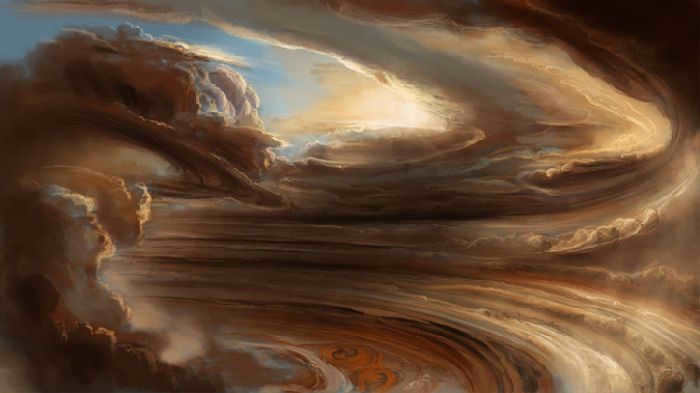
As the giant planets move towards the core, the internal pressure rises to such an extent that the hydrogen takes on a metallic form. This kind of matter cannot be achieved under normal Earth conditions. Beneath the layer of metallic hydrogen lies the nucleus.
Gas giants have a metal-silicate core at their center, devoid of hydrogen. The pressure at the very core of these planets is incredibly high, reaching up to 5 – 1011 Pa.
Imposing magnitude
The impressive magnitude is a significant characteristic of every colossal planet. Because of their substantial size, these planets have the capacity to accommodate numerous satellites and rings composed of variously sized ice and rocks. While all four colossal planets possess rings, it is Saturn that boasts the most prominent ones.
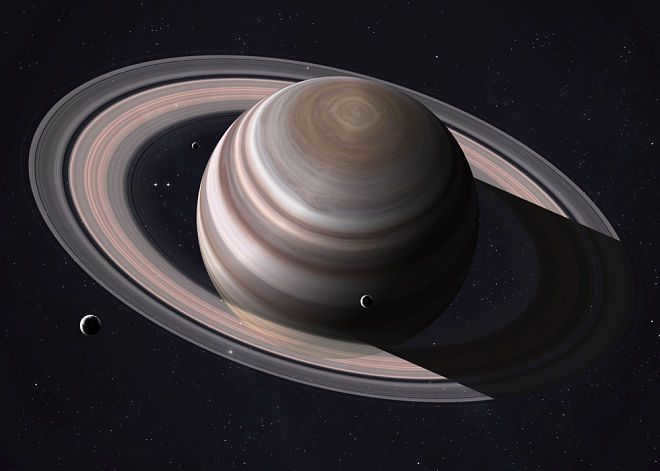
Neptune, with a radius of 24622 kilometers, is the smallest gas giant in our solar system. In contrast, Earth has a radius of only 6371 kilometers. Jupiter, on the other hand, is the largest giant planet in the solar system, with a radius of 69911 km, which is 318 times greater than Earth’s radius.
Characteristics of the atmosphere
The atmosphere of the giant planets is situated at a considerable distance from Earth, making it challenging to ascertain the precise chemical makeup of their inner layers. Nevertheless, the composition of their atmospheres is widely recognized. The predominant element in the atmospheres of the giant planets is hydrogen, ranging from 80% in Neptune to 96% in Saturn. Helium is the second most abundant element.
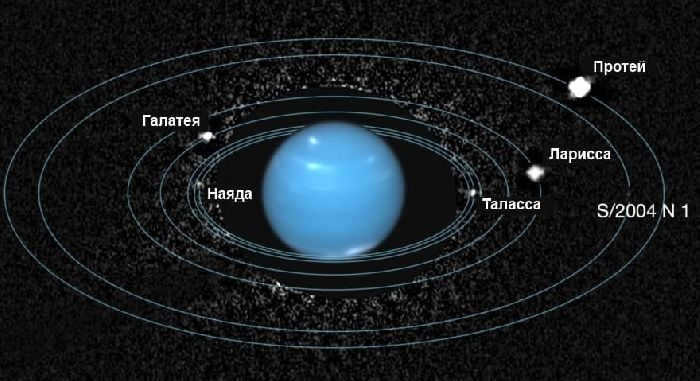
Illustration 3. Neptune accompanied by its moons.
Additional components can be found in the atmospheres of the gas giants, but collectively they make up no more than 2-3% of the total. These include carbon, nitrogen, sulfur, and oxygen, which combine to form substances like hydrogen sulfide, methane, water, phosphine, and ammonia.
What Did We Discover?
The colossal planets are a unique set of planets within our solar system that possess shared characteristics. Aside from their remarkable size, the most significant attribute of the structure of these massive planets is their lack of a solid surface. The primary constituent of these celestial behemoths is hydrogen, which can exist in three different forms: gaseous, liquid, and crystalline.
Giant planets are defined as planets that have a substantial mass and lack a solid surface. These types of planets are typically accompanied by numerous satellites. Within our solar system, there are four giant planets: Jupiter, Saturn, Uranus, and Neptune. These celestial bodies rank as the largest entities in our solar system, aside from the Sun. In this article, we will provide a concise overview of the unique characteristics that make up the internal structure of giant planets.
Lack of a solid ground
The primary characteristic that sets the giant planets apart is their lack of a solid surface. They are colossal globes primarily composed of gases. As a result, these massive planets are commonly referred to as gas giants.
As you delve deeper into the giant planets’ atmosphere, it becomes denser and transitions from a gaseous state to a liquid state. Unlike Earth, the gas giants lack a distinct boundary between the ocean and the atmosphere. Additionally, the ocean itself is not comprised of water, but rather liquid hydrogen.
As the giant planets approach their centers, the pressure increases to such an extent that hydrogen takes on a metallic structure, a state of matter that cannot be achieved under normal terrestrial conditions. Below the layer of metallic hydrogen lies the core.
Remarkable Scale
Impressive size is a defining characteristic of all giant planets. Their massive proportions allow for a plethora of satellites and rings composed of variously sized ice and rocks. While all four giant planets possess rings, Saturn’s are the most prominent.
Characteristics of the atmosphere
The atmosphere of the giant planets, located at a significant distance from Earth, makes it difficult to ascertain the precise chemical makeup of their inner layers. Nonetheless, the composition of their atmospheres is widely understood. Primarily, the atmospheres of these massive planets consist of hydrogen, ranging from 80% in Neptune to 96% in Saturn. Following hydrogen, helium is the second most abundant element in their atmospheres.
Neptune and its moons can be seen in Figure 3.
The atmospheres of the gas planets contain other elements, but their overall concentration is no more than 2-3%. These elements include carbon, nitrogen, sulfur, and oxygen, which combine to form compounds like hydrogen sulfide, methane, water, phosphine, and ammonia.
I am a physics, computer science, and computer engineering teacher. I have won the contest for the best teachers in Russia as part of the Priority National Project “Education”.
Saturn, the sixth planet from the Sun, is not one of the brightest objects in the night sky. However, its slow-moving, yellowish disk can still be easily seen with the naked eye. This is why people have been observing Saturn for centuries and considering it the farthest planet.
Saturn, which is a member of the gas giants and is the second largest planet in our solar system, has a composition that consists mostly of gases and lacks a solid surface. Similar to other planets, Saturn has a rotational motion that proceeds from west to east, but the rate of rotation varies depending on the latitude. In the equatorial regions, one complete revolution on its axis takes approximately 10 hours, 34 minutes, and 13 seconds, while in the circumpolar regions, it takes around 26 minutes longer.
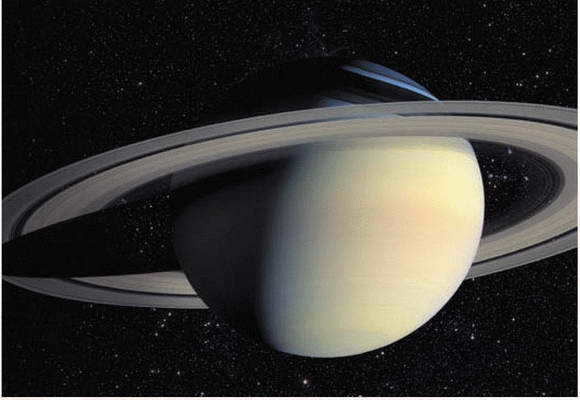
Saturn is a planet in our solar system
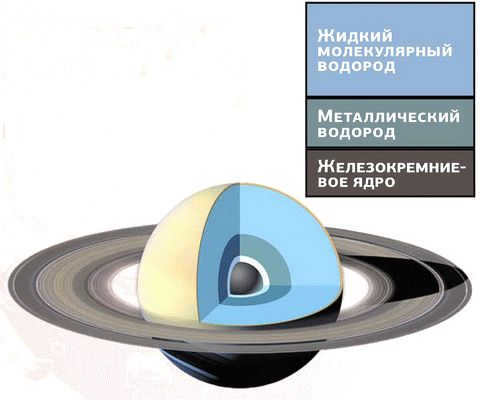
Composition of Saturn’s Interior
Saturn’s internal structure is unique due to its location in the solar system. Being nearly 10 times further from the Sun than Earth, the planet receives significantly less solar heat, about 90 times less than our home planet. Saturn’s orbit is relatively circular, but because of its massive size, there is a difference of approximately 160 million kilometers between its maximum and minimum distances from the Sun.
Saturn’s mass is equivalent to 95.2 times the mass of Earth, which may initially seem like an immense value. However, when taking into account that the volume of the planet is 800 times greater than that of Earth, the average density of Saturn is actually only 0.69 g/cm3! This gas giant is the sole planet in our solar system with an average density lower than that of water, which is 1 g/cm3 at a temperature of 4°C. Consequently, if the Universe contained an enormous tub of water or a suitably sized ocean, Saturn would effortlessly float on its surface without sinking!
The higher levels of Saturn’s turbid, highly compact atmosphere are comprised of roughly 93% hydrogen and 7% helium in terms of volume. Located at the upper extremity of the planet’s cloud layer, where the pressure is 0.1 atm, the temperature is approximately -190 °C. While this temperature is extremely frigid in comparison to Earth’s norms, Saturn emits 2.5 times more thermal energy than it absorbs from the Sun. This particular characteristic of Saturn serves as evidence that the planet generates its own heat.
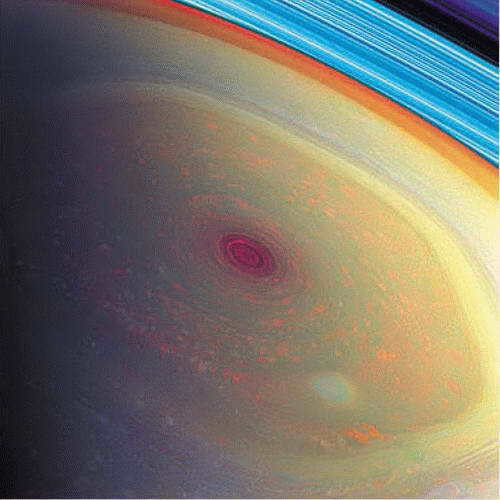
A distinct cloud formation in the shape of a regular hexagon, known as a hexagon, can be clearly seen at the north pole of Saturn
Saturn experiences hurricane-force winds, with speeds reaching up to 1800 km/h near the equator, which is three times faster than on Jupiter! While Saturn has fewer small atmospheric features, such as waves and knots, compared to Jupiter, its cloud bands are more prominent and can be seen at very high latitudes (78°).
In addition, Saturn’s atmosphere is periodically marked by powerful storms, hurricanes, and spots of various colors ranging from yellow to brown. It also has its own massive vortices, similar to Jupiter’s Great Red Spot, including the Great White Oval, the Great Brown Spot, and several smaller ones.
Astronomers have recently discovered polar lights on Saturn, where the upper atmosphere glows due to the influence of charged particles following magnetic field lines. These Saturnian auroras differ from those seen on Earth and Jupiter, as they not only form a ring but also have the ability to engulf the entire pole. This phenomenon can be observed at latitudes above 65 °, a feature that is unique to Saturn and not typically seen on our own planet.
During the early 1980s, while conducting research, scientists observed peculiar atmospheric phenomena at the north pole of Saturn through images captured by the American spacecraft Voyager-1 and Voyager-2. This phenomenon took the form of a regular hexagon, commonly referred to as a hexagen. The exact nature of this formation remains a mystery, although it is speculated to be an unconventional cloud vortex that extends deep into Saturn’s atmosphere, spanning approximately 100 km in distance. Remarkably, this structure is not only rotating but also of such colossal size that it could accommodate four Earths within its boundaries. Additionally, a circular aurora borealis can be witnessed above the cloud-filled hexagen.





